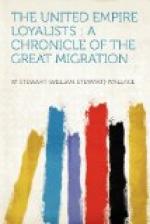Just before his death Sir William Johnson had interested himself in schemes for the colonization of his lands. In these he was remarkably successful. He secured in the main two classes of immigrants, Germans and Scottish Highlanders. Of the Highlanders he must have induced more than one thousand to emigrate from Scotland, some of them as late as 1773. Many of them had been Jacobites; some of them had seen service at Culloden Moor; and one of them, Alexander Macdonell, whose son subsequently sat in the first legislature of Upper Canada, had been on Bonnie Prince Charlie’s personal staff. These men had no love for the Hanoverians; but their loyalty to their new chieftain, and their lack of sympathy with American ideals, kept them at the time of the Revolution true almost without exception to the British cause. King George had no more faithful allies in the New World than these rebels of the ’45.
They were the first of the Loyalists to arm and organize themselves. In the summer of 1775 Colonel Allan Maclean, a Scottish officer in the English army, aided by Colonel Guy Johnson, a brother-in-law of Sir John Johnson, raised a regiment in the Mohawk valley known as the Royal Highland Emigrants, which he took to Canada, and which did good service against the American invaders under Montgomery in the autumn of the same year. In the spring of 1776 Sir John Johnson received word that the revolutionary authorities had determined on his arrest, and he was compelled to flee from Johnson Hall to Canada. With him he took three hundred of his Scottish dependants; and he was followed by the Mohawk Indians under their famous chief, Joseph Brant. In Canada Johnson received a colonel’s commission to raise two Loyalist battalions of five hundred men each, to be known as the King’s Royal Regiment of New York. The full complement was soon made up from the numbers of Loyalists who flocked across the border from other counties of northern New York; and Sir John Johnson’s ‘Royal Greens,’ as they were commonly called, were in the thick of nearly every border foray from that time until the end of the war. It was by these men that the north shore of the St Lawrence river, between Montreal and Kingston, was mainly settled. As the tide of refugees swelled, other regiments were formed. Colonel John Butler, one of Sir John Johnson’s right-hand men, organized his Loyal Rangers, a body of irregular troops who adopted, with modifications, the Indian method of warfare. It was against this corps that some of the most serious charges of brutality and bloodthirstiness were made by American historians; and it was by this corps that the Niagara district of Upper Canada was settled after the war.




